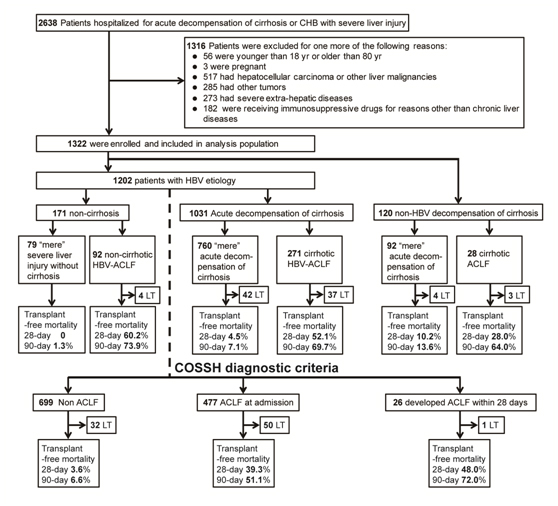Acute on chronic liver failure (ACLF) is a complex syndrome described as the acute deterioration in liver function in patients with pre-existing liver disease and the hepatic or extrahepatic organ failures which results in short-term mortality ranging from 50% to 90%. However, due to the variety of etiologies and demographic factors across the world, no universally accepted definition and diagnostic criteria of ACLF were available. Thus, it’s quite important to develop the definition and diagnostic and prognostic criteria for patients with HBV-related ACLF (HBV-ACLF) as no related evidence-based definition was put forward before.
Professor Jun Li and his research group in the State Key laboratory for Diagnosis and treatment of Infectious Diseases led by Prof. Lanjuan Li have done a large prospective study of the ACLF patients in China. This 5-year study was completed at the liver center of 13 famous Chinese hospitals including Ruijin Hospital, Southwest Hospital and No.302 Hospital. A total of 1,322 patients with chronic hepatitis B and severe liver injury(TB ≥ 5 mg/dL and INR ≥ 1.5) or with acute decompensation of cirrhosis were enrolled in this study. The article has been published in GUT online titled as “Development of diagnostic criteria and a prognostic score for hepatitis B virus-related acute-on-chronic liver failure”.
The results shows that HBV-ACLF can not only occur in cirrhotic patients but also in non-cirrhotic patients. Patients with HBV-ACLF have significantly higher 28-day mortality than the alcoholic related ACLF patients in the West. In addition, the most frequent organ failures of HBV-ACLF patients were liver and coagulation failures, differ from the kidney failure in ACLF patients in the western study. Patients with single liver failure exhibited a 28-day high mortality of 20.2% and should be diagnosed as ACLF.
Based on these results, the research group consider patients with HBV etiology, single liver failure (TB ≥ 12 mg/dL) and an INR ≥ 1.5 should be diagnosed as ACLF regardless of the presence of cirrhosis. Consequently, the group proposed new definition of HBV-ACLF (Chinese Group On the study for Severe Hepatitis B-ACLF, COSSH-ACLF). According to new diagnostic system,an additional 19% of patients were diagnosed with ACLF, indicating that these patients could receive clinically intensive management. The criteria is more sensitive in the early diagnosis of HBV-ACLF and it also can serve as a new evidence for the timely therapy for ACLF patients in China.
Dr. Tianzhou Wu, Dr. Jiang Li, and Dr. Li Shao equally contributed to this work, and it was supported by staffs in 13 liver centers of university hospitals.
